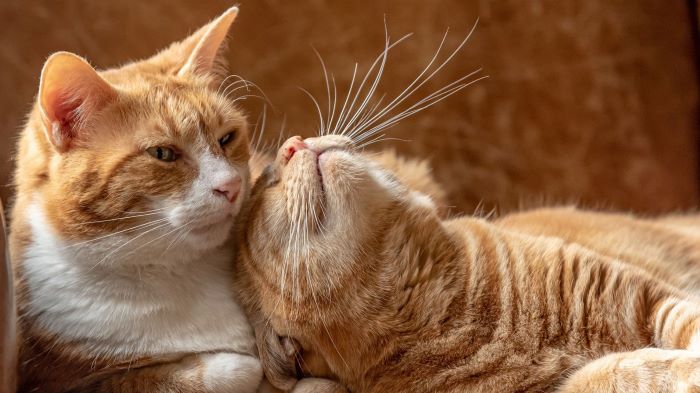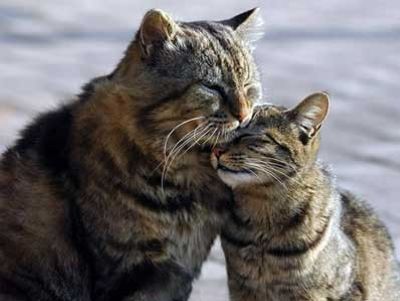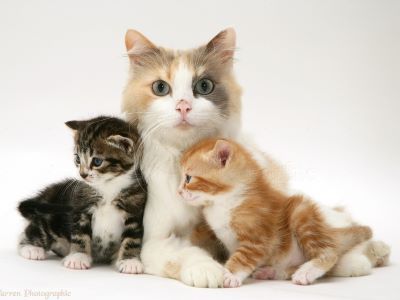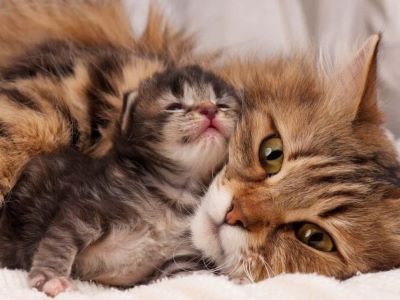Cats with their grace and charm have captured our hearts for ages. But beyond us how do they capture other cat’s hearts?
Do they go on dates in the backyard? Do females play hard to get? In this article, we will explore what drives this behavior and how they find a partner, and how they create new life.

Let’s understand everything about a cat’s reproduction.
Pre-mating Behavior
Cats, just like other animals, mate as part of their instinct to reproduce and ensure the survival of their species.
Understanding the reasons behind their mating behaviors sheds light on their evolutionary instincts and the survival of feline populations. Here are some of the signs:
Sexual Maturity to Mate
When a cat reaches sexual maturity, which generally happens between 5 to 9 months, they become capable of mating.
Once cats reach sexual maturity, their bodies undergo hormonal changes that prepare them for mating.
For female cats, this stage is called “estrus“ also known as “heat.” During estrus, a female cat becomes receptive to mating and exhibits specific signs.

such as calling, increased affection towards humans or objects, restlessness, and raising their hindquarters when stroked, known as the “lordosis” posture.
According to Dr. Malcolm Weir from VCA Hospitals, “The most notable signs of estrus in cats are behavioral. Most cats become very affectionate, even demanding”
“They persistently rub against people or objects such as furniture, rubbing against their owners and furniture and constantly demanding attention. This behavior attracts potential male mates”
Courtship
Courtship is an essential part of the mating process in cats, allowing potential partners to consider each other’s suitability for reproduction.
Male cats actively seek out females in estrus, using their keen sense of smell to detect the pheromones emitted by the females.
They may wander searching for receptive females and mark their territory with urine to signal their presence.
Male Cat Behaviors
When a male cat identifies a female in heat, he engages in courtship behaviors to attract her attention.
These behaviors include calling, such as yowling, to announce his presence and rubbing against objects or the female to leave his scent.
The male may also perform a “kneading” action with his paws near the female, a behavior similar to kitten nursing, as a display of affection.

Female Cat Behaviors
Female cats play a more passive role during courtship. They respond to the advances of male suitors by showing signs of receptiveness, such as raising their tails and assuming the mating position.
Females may also engage in playful behaviors to signal their interest, such as hitting or rolling on the ground.
Communication and Signals
Communication between mating partners is vital for a successful encounter. Both males and females emit specific pheromones to convey their reproductive status and availability. These chemical signals help potential mates recognize each other’s readiness for mating.
Additionally, calling and body postures also play a crucial role in expressing choices and consent during this process.
How Do Cats Mate?
Cats have a unique and charming way of mating, driven by their instincts to reproduce and ensure the survival of their species. Here’s some idea of how cats mate[1]:
- Pheromones: Before mating, female cats release special chemicals called pheromones. These pheromones act like tempting perfumes, attracting male cats from afar. Male cats can catch these scents with their keen sense of smell, which leads them to seek out the receptive female.
- Mounting and Copulation: Once a male cat finds a female in heat, he engages in a behavior known as mounting. He positions himself on top of the female and inserts his penis into her vagina, starting copulation. This process can be relatively quick, often lasting only a minute or so.

- Duration of Mating: The actual mating act itself doesn’t last very long, but the entire process, from courtship to copulation, may extend over several days during the female’s heat cycle.
- Reproduction: Female cats experience a unique reproductive phenomenon called caused ovulation. Unlike many other mammals, female cats do not release eggs from their ovaries until they mate. So, copulation triggers the release of eggs, increasing the likelihood of fertilization.
- Cat’s Reproductive Anatomy: To understand cat mating, it’s essential to know a bit about its reproductive anatomy. Female cats have a uterus and ovaries, while males possess testes that make sperm. The mating process brings these systems together for fertilization to occur.
- Ovulation: Female cats typically ovulate multiple eggs during their heat cycle. After mating, the eggs are ready to be fertilized by the male’s sperm. The sperm can remain viable in the female’s reproductive tract for several days, increasing the chances of successful fertilization even if mating occurs on different occasions during her heat cycle.
- Potential for Multiple Partners: During the breeding season, female cats can go through several heat cycles. This means they may mate with different males over a short period. As a result, a litter of kittens can have multiple fathers.
Pregnancy and Parenting
After mating, the female cat’s body releases eggs, a process called ovulation, which is triggered by the act of mating. If the eggs are fertilized by the male cat’s sperm, the female becomes pregnant.
The male cat plays no direct role in the pregnancy, but he may continue to mark his territory with urine after mating.
The gestation period for cats is about 63 to 65 days, during which the female carries and nurtures the growing kittens in her womb.
Once the kittens are fully developed, the mother gives birth to a litter, which can vary in size but usually ranges from one to six kittens[2].

“Cats can also suffer from false pregnancy or pseudopregnancy. It’s believed to be caused by hormonal imbalances that allow non-pregnant queens to show symptoms such as lactation and behavioral changes. These changes usually occur one to two months after her heat is over and can last for up to a month”, says an expert at PetMD.
After birth, the mother cat takes on the responsibility of parenting. She provides her kittens with milk to nourish them, keeps them clean by grooming them, and keeps them warm and safe.
As the kittens grow older, the mother teaches them essential survival skills through play and interaction.
Role of Cat Parents: How Can You Help?
After the delivery the real work begins, your cat will need your utmost attention and care.
If you don’t see the placenta or if the discharge is overly bloody or looks like pus, the cat should be examined by her vet as soon as possible. Here are some tips for your cat’s postpartum care[3]:
- Keep the area quiet and private
- Feed high-calorie diet
- Monitor Nursing and Lactation
- Keep Male Cats Separate From Your Female Cat After She Gives Birth
- Consider Spaying and Neutering
- Limit Handling Them During the First Weeks
- Watch For Struggling Kittens
- Start Socialization When the Kitten’s Eyes Begin to Open
- Start the Weaning Process at 3 to 4 Weeks
- Discuss Medical Care With Your Veterinarian

FAQs
When Is Mating Season for Cats Male?
As the days become longer and the temperatures rise, our cat’s hormones change in preparation for mating season. During spring, our feline friends and unneutered pet cats and strays begin searching for partners to produce the next generation.
How to Tell if Cat Mating Was Successful?
Your Cat’s Heat Cycle Has Changed. She’s More Loving Toward You. She’s Eating More. She’s Putting on Weight. Her Nipples Have Gotten Pinker and Bigger. Her Abdomen Is Swollen. She’s Looking for a Place to Have Kittens. She’s More Laid Back and Sleeping More Than Usual.
How Many Times Will a Female Cat Mate?
The female may mate 10 to 20 times on the first day and may mate with several males over four to six days. This long period of receptiveness gives the cat a chance to ovulate and to choose the best male; one which is healthy and in his prime.
Why Do Female Cats Attack Males After Mating?
Female cats also feel a burst of hormones right after mating, which causes some of them to become aggressive right after intercourse, raging at their mates. Many felines will show territorial aggression right after mating, attack the male, and want to get rid of the smell on their bodies.
How Do I Stop My Male Cat From Trying to Mate?
Neutering is the most apparent option for dealing with sexual behaviors in male cats. After castration, a cat’s testosterone levels drop drastically, causing them to lose their desire to mate. Most pet parents find that sexual behaviors like spraying and roaming diminish or stop entirely after neutering.
Do Female Cats Enjoy Mating?
Mating isn’t always pleasant for the female cat, but they mate because nature makes animals want to mate to continue their species, but when there are too many of their species, then they may not live a happy life so humans have to help control their population by spaying and neutering pets.
Conclusion
So next time you wonder how cats mate? Then know that cat mating is an intriguing process guided by courtship and instinctual behaviors.
It involves copulation, resulting in fertilization during the breeding season. The flow of life continues as kittens are nurtured and raised with boundless love.
Understanding this aspect of a cat’s life helps us appreciate the wonder of nature.
Reference:
- Little, S. J. (2012). Female reproduction. In Elsevier eBooks (pp. 1195–1227)- PMC
- Preis, M. W. (2015, May 27). What to expect when your cat is pregnant– WebMD
- Hoffmann, H., DVM. (2022). Cat Pregnancy and Kittens: The Complete Guide– PetMD

